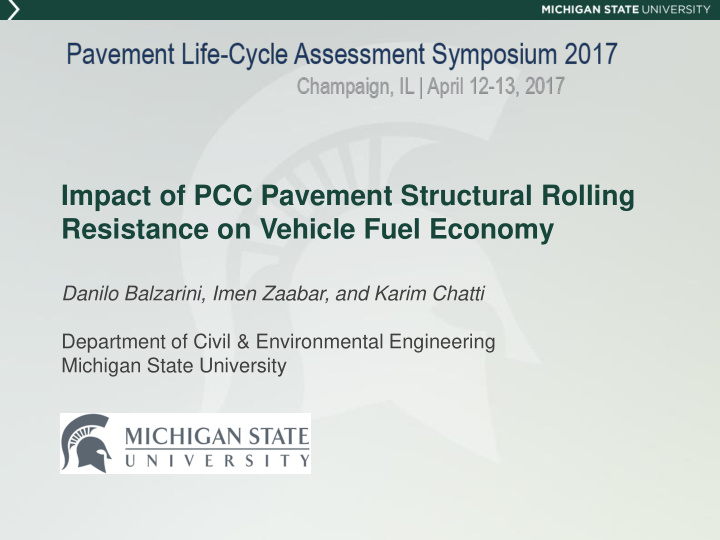



Impact of PCC Pavement Structural Rolling Resistance on Vehicle Fuel Economy Danilo Balzarini, Imen Zaabar, and Karim Chatti Department of Civil & Environmental Engineering Michigan State University
Acknowledgements This study was conducted in collaboration with Dr. John Harvey (University of California, Davis) and Dr. Erdem Coleri (Oregon State University). The authors would like to acknowledge the financial support of the California Department of Transportation . 2
Outline Introduction Objective Approach Calculation of the fuel consumption due to the structural rolling resistance Results Conclusion 3
Factors Affecting Fuel Consumption Vehicle Thermodynamic efficiency of the engine Aerodynamics Weight Technological characteristics of the tire: • Inflation Pressure • Temperature • Design, materials, dimensions Pavement Geometry Surface characteristics Structural behavior of the pavement 4
Objective Evaluate the effects of concrete pavement structural characteristics on rolling resistance (SRR) and fuel consumption using a mechanistic approach 5
Approach 6
Backcalculation Eliminate the noise from the FWD time histories Use FFT algorithm to decompose the deflection signal of each sensor into a series of harmonic motions Use a closed form solution for the dynamic backcalculation of the effective k and c values for the base/subgrade Use the best fit method to get the static k value and the elastic modulus of the concrete slab Compare the static and dynamic k values 7
Dynamic Backcalculation (Chatti, 1992) Re( P ) Re UdA Im( P ) Im UdA 0 0 2 A A k 2 2 Re UdA Im UdA A A Re( P ) Im UdA Im( P ) Re UdA 0 0 1 A A c 2 2 Re UdA Im UdA A A 8
FWD Deflection Time Histories 9
DYNASLAB (Chatti, 1992) 2D Dynamic FE model with moving loads Elastic slabs on damped Winkler foundation Load transfer across joints modeled by a Kelvin- Voigt model (vertical spring K AGG and dashpot C AGG in parallel) 10
Load Transfer Efficiency i 1 LTE (%) 100 i Sensitivity analysis to correlate K AGG and C AGG to the LTE of the joints LTE sensitive to K AGG , not sensitive to C AGG Even when LTE=100% joints have an impact on the pavement response 11
Deflection as Seen by a Moving Vehicle 12
Slope as Seen by a Moving Vehicle Front wheels of Tandem axle Rear wheels of Tandem axle 13
Vehicle Energy Loss dw x t ( , ) n m dw x y z t ( , , , ) j j str P p dS W p S x RR RR i i dt dx i 1 j 1 S 1000 W [ MJ km / ] W diss RR L Assumptions: quasi-static regime non-dissipative tires To take into account the dependency of the slope on time and on the location of the load, the slab is divided into m intervals of length Δx 14
Calculation of Fuel Consumption Fuel consumption due to W diss Fuel structural rolling resistance RR b b [MJ/L] Type of engine b is the calorific value of Gasoline 10.5 the fuel. Diesel 16 Percent fuel Fuel W consumption excess RR diss Fuel 100 100 excess Fuel Fuel C b C (due to SRR) 15
Pavement Sections 16
Vehicle Characteristics and Positions Vehicle Characteristics Vehicle Class Number of Number of Load per Axle Load per Tire axles tires [kN] [kN] Medium Car 2 4 7.15 3.58 2 4 SUV 12.25 6.13 1 4 Loaded Truck 151.41 37.85 17
Excess Fuel Consumption Results – Truck Tandem Axle 18
Excess Fuel Consumption Results - SUV 19
Excess Fuel Consumption Results - Car 20
Contribution of Rolling Resistance to Fuel Consumption F C [mL/km] (using % FC due to SRR % FC due to SRR NCHRP720 model) Edge Loading Offset Loading 50 km/h 100 km/h 50 km/h 100 km/h 50 km/h 100 km/h Medium Car 70.0 95.6 0.002 0.002 0.001 0.002 SUV 78.7 120.9 0.004 0.006 0.003 0.004 Loaded Truck 273.4 551.7 0.072 0.081 0.064 0.072 SRR contribution to FC is less than 0.1% 21
Conclusion The excess fuel consumption of a vehicle travelling on concrete pavements due to the SRR is a very small quantity: less than 0.1% of the total fuel consumption of the truck. While this excess fuel consumption due to the structural rolling resistance is very small, it has been shown that: Increasing the speed increases the fuel consumption due to SRR. The fuel consumption due to SRR increases as the wheel is closer to the slab edge. A stronger foundation (base and subgrade) reduces the fuel consumption due to SRR. 22
Future Studies Study the effect of shoulders/adjacent lanes and LTE less than 100% Consider the curling and warping effects Compare the results with simulations on asphalt and composite pavements Thank you for your attention! 23
Questions? 24
Recommend
More recommend